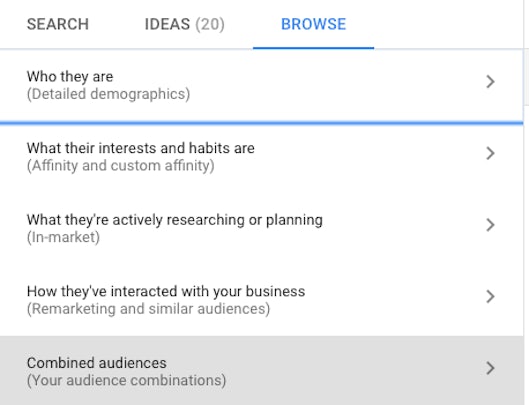Last week, Google Ads rolled out the ‘Combined Audiences’ feature, allowing users to layer detailed demographics, affinity/custom affinity, in-market, and remarketing audiences to target very specific users much more accurately than was possible before.
The potential impact this could have on conversion rates of certain campaigns could be significant, but before going into the details of the implications of this feature, you need to know how to set it up!
How to set up Combined Audiences
Getting Combined Audiences up and running on your accounts couldn’t be simpler. First, navigate to the campaign you want to apply the audience to, and select the audiences tab. Hit the button to add a new audience, then go to the ‘browse’ tab. At the bottom of the list you’re presented with, you’ll see the option for Combined Audiences. Select this and hit ‘New Combined Audience’.

This will open a pop-up which will allow you to build a combined audience, which you can see an example of below. Here I’ve created an audience which targets any previous website visitors from the last 180 days, who have also got a Bachelor’s or higher degree and are in-market for business & industrial products. As the link between each condition is AND rather than OR, users who fall into this audience must fit all conditions rather than just fitting any single one. It’s also possible to exclude audience segments from your Combined Audience in this window.

Having set up your Combined Audience simply hit create and apply the new audience to any campaigns that will benefit from stricter targeting rules.
Why are Combined Audiences important?
Combined Audiences will have a couple of consequences for Google Ads accounts. The first and most obvious is that more specific audience targeting will allow us to create personas of users who are highly likely to convert and force more budget to be spent on these users. This could be through setting up positive bid modifiers in campaigns using manual bidding or creating a separate campaign set to ‘targeting’ on your Combined Audience in order to allocate the audience its own budget.
Potentially more interesting is that this new targeting method could be a potential game-changer when it comes to structuring accounts. Combined Audiences will allow account managers to create audience-centric account structures, which will be especially important in accounts where search query intent is hard to quantify. Broadening keyword targeting to capture more search volume while restricting ad exposure to highly qualified users based on Combined Audience segments will mean that reach can be expanded without wasting budget on the wrong users. As Google continues to roll out more advanced audience targeting options, account managers will be able to create even more targeted personas using Combined Audiences, meaning we could see a shift away from keyword-centric campaigns towards more audience-centric structures.
Of course, the data on how well these audiences are working is currently very limited. Early results on Twitter indicate increased conversion rates from using Combined Audiences, but the sample size here really is too small to be conclusive. At Impression we’re constantly looking for ways to improve our Google Ads accounts, so we’ll be testing Combined Audiences over the next few weeks and will share our results once they are clear!
More information on Combined Audiences can be found here.





